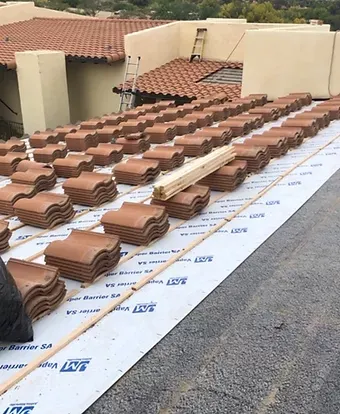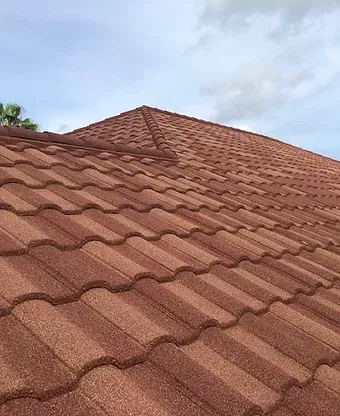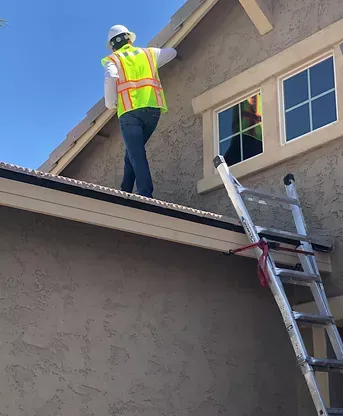Common Tile Roof Repairs and Maintenance for Southwest Florida Homes
Common Tile Roof Repairs and Maintenance for Southwest Florida Homes
Understanding Tile Roofs in Southwest Florida
Tile roofs are a popular choice for homeowners in Southwest Florida due to their durability, aesthetic appeal, and ability to withstand the region's unique climate. Clay and concrete tiles are the two main materials used, each offering distinct benefits. Clay tiles are known for their classic Mediterranean look and resistance to heat, while concrete tiles provide excellent strength and versatility in design. These materials not only enhance curb appeal but also contribute to energy efficiency by reflecting sunlight and reducing heat absorption.
Beyond their beauty, tile roofs are highly durable, often lasting 50 years or more with proper care. Their resilience to high winds, heavy rains, and intense UV exposure makes them ideal for Southwest Florida's tropical and subtropical weather. This combination of longevity and performance ensures that tile roofs remain a top choice for homeowners seeking both style and practicality. Understanding these strengths sets the stage for effective maintenance and timely repairs.
Typical Causes of Tile Roof Damage
Despite their durability, tile roofs in Southwest Florida are susceptible to damage from various factors. Hurricanes and high winds are among the most significant threats , capable of dislodging or cracking tiles. Debris from nearby trees can also cause damage during storms, while prolonged UV exposure may lead to fading or brittleness over time. These environmental stressors highlight the importance of regular upkeep to prevent minor issues from escalating into major problems.
Another common cause of tile roof damage is the natural aging of materials. Over time, even the sturdiest tiles can wear down due to constant exposure to heat, humidity, and rain. This gradual deterioration can compromise the roof's structural integrity and waterproofing capabilities. Recognizing these causes early on allows homeowners to address potential issues before they result in costly repairs or replacements.
Signs Your Tile Roof Needs Repair
Homeowners should be vigilant about spotting signs that their tile roof requires attention. Cracked, chipped, or slipped tiles are some of the most obvious indicators of damage. These issues can expose the underlayment to the elements, increasing the risk of leaks and water infiltration. Additionally, visible water stains on ceilings or walls inside the home often signal that moisture is seeping through the roof structure.
Debris accumulation, such as leaves and branches, is another warning sign that shouldn’t be ignored. Clogged gutters and drains can lead to water pooling, which accelerates wear and tear. By staying alert to these signals, homeowners can take proactive steps to address problems early and avoid more extensive damage down the line.
Inspection Practices for Southwest Florida Tile Roofs
Regular professional inspections are crucial for maintaining the health of a tile roof. A thorough inspection typically involves checking for cracked or missing tiles, assessing the condition of flashings, and examining the underlayment for signs of wear or water damage. Inspectors also look for hidden issues, such as mold growth or pest infestations, which could compromise the roof’s integrity if left untreated.
In Southwest Florida, where extreme weather is common, inspections should be conducted at least twice a year—before and after hurricane season. Post-storm inspections are especially important to identify any storm-related damage. By prioritizing routine checks, homeowners can catch small problems early and ensure their roofs remain in optimal condition year-round.
Common Tile Roof Repairs
One of the most frequent repair tasks for tile roofs is replacing cracked or broken tiles. This process involves carefully removing the damaged tile and installing a new one that matches the existing roof's color and texture. Fixing leaks is another common job , often requiring repairs to the underlayment or flashing to restore the roof’s waterproof barrier.
Flashing issues are also a typical concern, particularly around chimneys, vents, and skylights. Damaged flashing can allow water to seep into the roof structure, leading to costly interior damage. In cases of severe storm damage, entire sections of the roof may need to be repaired or reinforced to prevent future problems.
Hurricane and storm damage often necessitate comprehensive repairs , including securing loose tiles, replacing damaged underlayment, and reinforcing vulnerable areas. Addressing these issues promptly helps protect the home from further harm and ensures the roof remains functional and secure.
Replacing Individual Tiles vs. Full Roof Replacement
When it comes to tile roof repairs, deciding between replacing individual tiles and opting for a full roof replacement depends on several factors. Targeted tile replacement is usually sufficient for addressing isolated damage, such as a few cracked or missing tiles. This approach is cost-effective and minimally invasive, making it an attractive option for newer roofs with minimal overall wear.
On the other hand, full roof replacement may be necessary if the roof is nearing the end of its lifespan or has sustained widespread damage. Factors like age, extent of deterioration, and frequency of past repairs play a role in this decision. Consulting with a professional can help homeowners determine the best course of action based on their specific circumstances.
Tile Roof Maintenance Essentials
Proper maintenance is key to extending the life of a tile roof. Regular cleaning is essential to remove dirt, algae, moss, and debris that can trap moisture and cause damage. Homeowners should also clear gutters and downspouts to ensure proper drainage and prevent water buildup. Neglecting these tasks can lead to premature wear and costly repairs.
Mold and moss growth are particular concerns in Southwest Florida’s humid climate. Applying specialized treatments can help inhibit their development and preserve the roof’s appearance. Additionally, inspecting and maintaining flashings and sealants around roof penetrations can prevent leaks and water intrusion. These preventative measures go a long way in safeguarding the roof against environmental stressors.
Routine maintenance not only enhances the roof’s longevity but also boosts property value. By addressing minor issues early and adhering to a consistent care schedule, homeowners can enjoy peace of mind knowing their roof is resilient and reliable.
Protecting Your Roof from Storms and Hurricane Damage
Preparation is critical to protecting a tile roof from storm and hurricane damage. Before hurricane season, homeowners should trim overhanging tree branches, secure loose tiles, and reinforce weak points such as flashings and eaves. Installing impact-resistant tiles or adding bracing systems can further enhance the roof’s ability to withstand high winds and flying debris.
After a storm, conducting a thorough inspection is vital to identify any damage that may have occurred. Look for missing or displaced tiles, dented metal components, and signs of water intrusion. Promptly addressing these issues prevents further deterioration and ensures the roof remains in good condition throughout the year.
Choosing a Reliable Tile Roof Contractor in Southwest Florida
Selecting the right contractor is essential for quality tile roof repairs and maintenance. Homeowners should prioritize companies with certifications from reputable organizations, such as the National Roofing Contractors Association (NRCA). Experience in working with tile roofs in Southwest Florida’s climate is another important factor, as it ensures familiarity with local challenges and solutions.
Customer reviews and service guarantees provide additional insights into a contractor’s reliability and professionalism. Asking for references and comparing quotes from multiple providers can help homeowners make informed decisions. Partnering with a trusted expert ensures that repairs and maintenance are performed to the highest standards, protecting the roof’s longevity and performance.
Common Tile Roof Materials and Their Benefits
Clay and concrete are the most popular materials for tile roofs in Southwest Florida, each offering unique advantages. Clay tiles are prized for their timeless elegance and exceptional heat resistance, making them ideal for the region’s hot summers. They are also naturally fireproof and eco-friendly, adding to their appeal.
Concrete tiles , on the other hand, provide superior strength and versatility in design. They can mimic the appearance of wood, slate, or traditional clay while offering enhanced durability and affordability. Both materials excel in resisting moisture, pests, and UV rays, ensuring they stand up well to Southwest Florida’s demanding climate.
How Weather Affects Tile Roofs in Southwest Florida
Southwest Florida’s weather patterns pose unique challenges for tile roofs. The combination of intense heat, high humidity, and frequent storms can accelerate wear and tear if proper precautions aren’t taken. Heat can cause tiles to expand and contract, potentially leading to cracks, while humidity fosters mold and algae growth.
Storms bring additional risks, including wind-driven debris and heavy rainfall. These conditions underscore the importance of regular maintenance and timely repairs. By understanding how weather impacts tile roofs, homeowners can implement strategies to mitigate damage and extend their roofs’ lifespans.
Costs and Insurance for Tile Roof Repairs and Maintenance
The cost of tile roof repairs and maintenance varies depending on the scope of work. Replacing individual tiles typically ranges from $10 to $30 per tile, while larger repairs, such as fixing leaks or replacing underlayment, can cost several hundred dollars. Professional inspections generally range from $200 to $500, depending on the size of the roof and complexity of the assessment.
Insurance coverage for tile roof repairs often includes damage caused by storms or hurricanes, though policies vary. Homeowners should review their coverage details and document any storm-related damage thoroughly to facilitate claims. Working with a knowledgeable contractor can also help ensure accurate estimates and smooth interactions with insurance providers.
FAQ: Common Tile Roof Repairs and Maintenance Questions
How often should a tile roof be inspected in Southwest Florida?
In Southwest Florida, tile roofs should be inspected at least twice a year—before and after hurricane season. Additional inspections are recommended after major storms to identify and address any storm-related damage promptly.
What is the lifespan of a typical tile roof in this region?
A well-maintained tile roof in Southwest Florida can last 50 years or more. Factors such as material quality, installation expertise, and regular maintenance significantly influence its longevity.
Can individual tiles be replaced, or is full roof replacement necessary?
Individual tiles can often be replaced when damage is isolated. However, full roof replacement may be necessary if the roof is older or has extensive damage affecting its structural integrity.
What are the most common signs of a leaking tile roof?
Common signs include water stains on ceilings or walls, damp insulation, mold growth, and visible gaps or cracks in the tiles. Early detection helps prevent costly interior damage.
Is professional cleaning required, or can homeowners safely clean their tile roofs?
While minor cleaning can be done by homeowners, professional cleaning is recommended for safety and effectiveness. Professionals have the tools and expertise to remove stubborn stains and prevent damage during the process.
Conclusion
Regular repairs and maintenance are essential for preserving the integrity of tile roofs in Southwest Florida. By addressing issues early and adhering to a consistent care routine, homeowners can protect their roofs from storm damage, enhance property value, and avoid expensive repairs. Investing in professional inspections and timely interventions ensures lasting roof health and peace of mind.
Schedule an inspection today and partner with a reputable contractor to keep your tile roof in top condition. Remember, proactive care is the key to enjoying a beautiful, durable roof that stands strong against the elements. With proper attention, your tile roof will continue to serve as a reliable shield for your home for decades to come.




